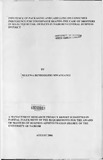| dc.description.abstract | Packaging and labeling have increasingly gained popularity as competitive marketing weapons.
In the present day crowded retail shelf, packaging designs must be crafted to cut through such
clutter, differentiate brands from competitive offerings, and stimulate the desire to purchase.
This study sought to determine the influence of toothpaste packaging and labeling on brand
preference, and whether the influence, if any, differs according to certain socio-demographic
dimensions of consumers. The research design in this study was descriptive. The population of
interest comprised shoppers in key retail outlets in Nairobi's Central Business District. The
researcher sampled and interviewed 200 shoppers, and achieved 100% response rate.
Respondents were selected via convenience sampling, with an equal number of shoppers being
drawn from each outlet. Primary data was collected using a semi-structured questionnaire, and
analyzed using frequency distribution, mean scores and standard deviation. Data presentations
were made using tables.
The study findings revealed that, packaging and labeling act as the silent salesman on the shelf in
influencing consumer preference for toothpaste brands. Brand name, color, design, package
material, product life, and pack size emerged to be the most influential components, while use
instructions, grade information, texture of packaging material, and graphic illustration influenced
preference to a moderate extent. None of the components under consideration slipped into the
third category of 'small extent' influence. Furthermore, it was established that the influence of
packaging and labeling on toothpaste brands preference differs according to certain sociodemographic
dimensions of consumers, which include income, gender, age and education to
mention but a few. The above .outcomes strongly attest to the assertion that, packaging and
labeling have become the centerpiece between brand appeal and consumer purchase decision,
and should be treated as key elements of the marketing mix strategy and not a side issue.
On the basis of the foregoing findings, it was recommended that marketers of toothpaste brands
should firmly focus on packaging and labeling components that appeared to influence preference
to a great extent, and continuously conduct consumer research with a view to identifying other
components scaling the consumer preference ladder so as to accord them due attention.
The study was only confmed to Nairobi's Central Business District. Consequently, the researcher
suggested that in future, it should be rolled out to peri-urban and rural settings in order to give a
holistic picture on the extent of packaging and labeling influence on toothpaste brands preference
by diverse consumers. | en |

